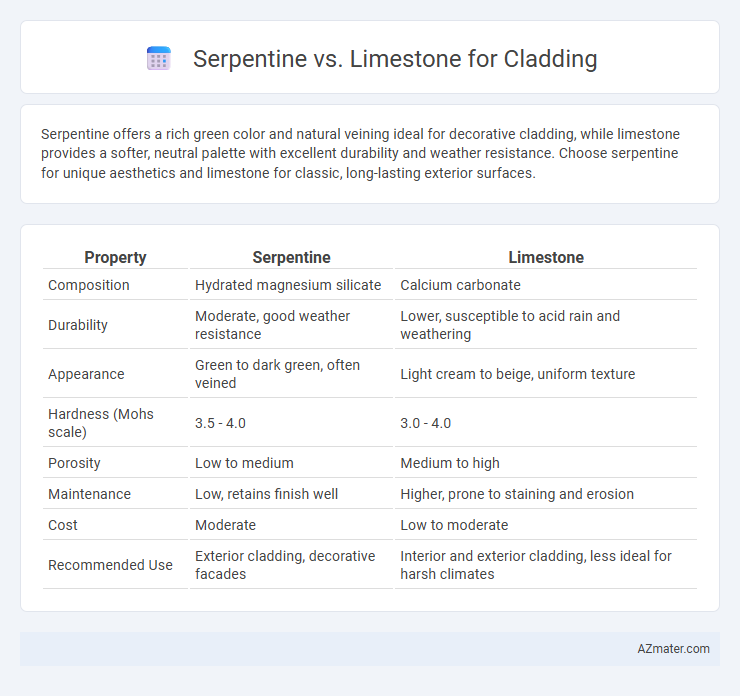Serpentine offers a rich green color and natural veining ideal for decorative cladding, while limestone provides a softer, neutral palette with excellent durability and weather resistance. Choose serpentine for unique aesthetics and limestone for classic, long-lasting exterior surfaces.
Table of Comparison
| Property | Serpentine | Limestone |
|---|---|---|
| Composition | Hydrated magnesium silicate | Calcium carbonate |
| Durability | Moderate, good weather resistance | Lower, susceptible to acid rain and weathering |
| Appearance | Green to dark green, often veined | Light cream to beige, uniform texture |
| Hardness (Mohs scale) | 3.5 - 4.0 | 3.0 - 4.0 |
| Porosity | Low to medium | Medium to high |
| Maintenance | Low, retains finish well | Higher, prone to staining and erosion |
| Cost | Moderate | Low to moderate |
| Recommended Use | Exterior cladding, decorative facades | Interior and exterior cladding, less ideal for harsh climates |
Introduction to Cladding Materials
Serpentine and limestone are popular cladding materials distinguished by their unique geological properties and aesthetic appeal. Serpentine offers a rich green hue with natural veining, providing a durable and weather-resistant surface ideal for exterior facades. Limestone, known for its soft texture and neutral tones, is favored for its versatility and ease of maintenance in both traditional and modern architectural designs.
What is Serpentine?
Serpentine is a metamorphic rock characterized by its greenish color and smooth, waxy texture, making it a popular choice for architectural cladding due to its aesthetic appeal and durability. Composed mainly of magnesium silicate minerals, serpentine offers natural resistance to weathering and corrosion, which enhances its longevity in exterior applications compared to traditional limestones. Unlike limestone, which is primarily calcite and more porous, serpentine's moderate hardness and distinct veining patterns provide unique visual and structural advantages in cladding projects.
What is Limestone?
Limestone is a sedimentary rock primarily composed of calcium carbonate, often formed from marine organisms' skeletal fragments. Its durability and natural beauty make it a popular choice for architectural cladding, providing a classic and elegant finish. Limestone's porosity and color variations require proper sealing and maintenance to ensure long-lasting performance in building facades.
Appearance and Aesthetic Differences
Serpentine cladding features a deep green to dark green color with a smooth, sometimes mottled texture that offers a luxurious, natural look ideal for creating bold, statement facades. In contrast, limestone cladding typically presents a lighter, creamy beige to pale gray palette with a fine, uniform grain that provides a soft, classic appearance suitable for traditional and contemporary designs. The unique veining and varying finishes of serpentine add dynamic visual interest, while limestone's consistent tones offer timeless elegance and versatility in architectural applications.
Durability and Weather Resistance
Serpentine offers superior weather resistance due to its natural oil content, which enhances water repellency and prevents surface deterioration, making it highly durable in humid and wet climates. Limestone, while aesthetically versatile, is more porous and prone to acid rain erosion and freeze-thaw damage, reducing its longevity in harsh weather conditions. For exterior cladding, serpentine's dense structure and resistance to chemical weathering provide a longer-lasting, low-maintenance solution compared to limestone.
Installation and Workability
Serpentine offers superior workability for cladding projects due to its relative softness and ease of cutting, allowing for intricate designs and faster installation. Limestone, while durable, is denser and requires more specialized tools and skilled labor, which can extend installation time and increase costs. Both materials require careful handling to prevent damage, but serpentine's lighter weight and flexibility often result in more efficient and adaptable cladding applications.
Cost Comparison
Serpentine cladding generally offers a higher upfront cost compared to limestone due to its rarity and complex quarrying process. Limestone remains more cost-effective, making it a popular choice for budget-conscious projects without compromising durability. Installation expenses for both materials are comparable, but long-term maintenance for serpentine can increase total lifecycle costs.
Environmental Impact and Sustainability
Serpentine and limestone both offer distinct environmental impacts and sustainability profiles when used for cladding. Serpentine, often sourced locally, has lower embodied energy due to reduced transportation emissions, while limestone extraction typically involves higher carbon emissions from quarrying and processing. Limestone's natural durability and recyclability contribute to long-term sustainability, but serpentine's resistance to weathering and natural thermal insulation properties enhance its eco-friendly appeal in building applications.
Maintenance Requirements
Serpentine cladding demands regular sealing to prevent moisture absorption and maintain its vibrant green hue, while limestone requires periodic cleaning to avoid surface erosion and staining due to its porous nature. Both materials benefit from prompt removal of pollutants and biological growth to preserve their structural integrity. Professional inspection every few years is recommended to address any weathering or damage, ensuring long-term durability for exterior applications.
Choosing the Right Cladding: Serpentine or Limestone?
Serpentine cladding offers a unique blend of deep green hues and exceptional durability, making it ideal for contemporary architectural designs requiring weather resistance and visual impact. Limestone provides a timeless, classic aesthetic with a softer tone and excellent thermal insulation properties, suitable for traditional or historic building facades. The choice between serpentine and limestone cladding hinges on balancing aesthetic preferences, environmental conditions, and long-term maintenance needs specific to the building's location and design goals.

Infographic: Serpentine vs Limestone for Cladding
 azmater.com
azmater.com